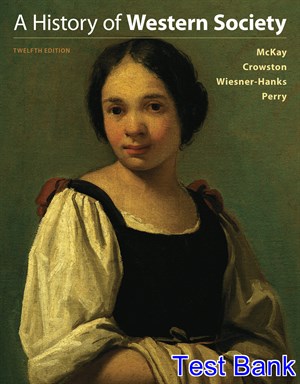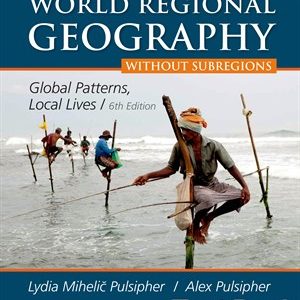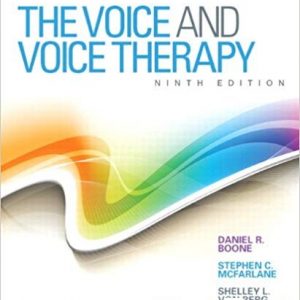This is completed downloadable of History of Western Society 12th Edition McKay Test Bank

Product Details:
ISBN 10: 1319053955
ISBN 13: 9781319053956
Author: McKay
Praised by instructors and students alike for its readability and attention to everyday life, the twelfth edition of A History of Western Society includes many tools to engage today’s students and save instructors time. This edition features a comprehensive primary source program, five chapters devoted to the lives of ordinary people that make the past real and relevant, and the best and latest scholarship throughout.
With over 200 written and visual primary sources included in the document features “Evaluating the Evidence” and “Thinking like a Historian,” students connect to the past through an array of evidence.
The book can be purchased with the breakthrough online resource, LaunchPad, which combines an e-book with a wealth of time-saving teaching and learning tools. LaunchPad comes with LearningCurve, an adaptive and automatically graded learning tool that ensures students come to class prepared.
This is a stand alone textbook. This is an evaluation copy for Instructor’s. Praised by instructors and students alike for its readability and attention to everyday life, the twelfth edition of A History of Western Society includes many tools to engage today’s students and save instructors time. This edition features a comprehensive primary source program, five chapters devoted to the lives of ordinary people that make the past real and relevant, and the best and latest scholarship throughout. Enhanced with a wealth of digital content in LaunchPad, the twelfth edition provides easily assignable options for instructors and novel ways for students to master the content. Integrated with LearningCurve, an adaptive online resource that helps students retain the material and come to class prepared.
Table of contents
- PERIOD ONE: From Renaissance to Early Modern
- 11 The Later Middle Ages 1300–1450
- Prelude to Disaster
- Climate Change and Famine
- Social Consequences
- The Black Death
- Pathology
- Spread of the Disease
- Care of the Sick
- Economic, Religious, and Cultural Effects
- The Hundred Years’ War
- Causes
- English Successes
- Joan of Arc and France’s Victory
- Aftermath
- Challenges to the Church
- The Babylonian Captivity and Great Schism
- Critiques, Divisions, and Councils
- Lay Piety and Mysticism
- Social Unrest in a Changing Society
- Peasant Revolts
- Urban Conflicts
- Sex in the City
- Fur-Collar Crime
- Ethnic Tensions and Restrictions
- Literacy and Vernacular Literature
- Notes
- 11 Review & Explore
- 12 European Society in the Age of the Renaissance 1350–1550
- Wealth and Power in Renaissance Italy
- Trade and Prosperity
- Communes and Republics of Northern Italy
- City-States and the Balance of Power
- Intellectual Change
- Humanism
- Education
- Political Thought
- Christian Humanism
- The Printed Word
- Art and the Artist
- Patronage and Power
- Changing Artistic Styles
- The Renaissance Artist
- Social Hierarchies
- Race and Slavery
- Wealth and the Nobility
- Gender Roles
- Politics and the State in Western Europe
- France
- England
- Spain
- Notes
- 12 Review & Explore
- 13 Reformations and Religious Wars 1500–1600
- The Early Reformation
- The Christian Church in the Early Sixteenth Century
- Martin Luther
- Protestant Thought
- The Appeal of Protestant Ideas
- The Radical Reformation and the German Peasants’ War
- Marriage, Sexuality, and the Role of Women
- The Reformation and German Politics
- The Rise of the Habsburg Dynasty
- Religious Wars in Switzerland and Germany
- The Spread of Protestant Ideas
- Scandinavia
- Henry VIII and the Reformation in England
- Upholding Protestantism in England
- Calvinism
- The Reformation in Eastern Europe
- The Catholic Reformation
- Papal Reform and the Council of Trent
- New and Reformed Religious Orders
- Religious Violence
- French Religious Wars
- The Netherlands Under Charles V
- The Great European Witch-Hunt
- Notes
- 13 Review & Explore
- 14 European Exploration and Conquest 1450–1650
- World Contacts Before Columbus
- The Trade World of the Indian Ocean
- The Trading States of Africa
- The Ottoman and Persian Empires
- Genoese and Venetian Middlemen
- The European Voyages of Discovery
- Causes of European Expansion
- Technology and the Rise of Exploration
- The Portuguese Overseas Empire
- Spain’s Voyages to the Americas
- Spain “Discovers” the Pacific
- Early Exploration by Northern European Powers
- Conquest and Settlement
- Spanish Conquest of the Aztec and Inca Empires
- Portuguese Brazil
- Colonial Empires of England and France
- Colonial Administration
- The Era of Global Contact
- Indigenous Population Loss and Economic Exploitation
- Life in the Colonies
- The Columbian Exchange
- Sugar and Slavery
- Spanish Silver and Its Economic Effects
- The Birth of the Global Economy
- Changing Attitudes and Beliefs
- Religious Conversion
- European Debates About Indigenous Peoples
- New Ideas About Race
- Michel de Montaigne and Cultural Curiosity
- William Shakespeare and His Influence
- Notes
- 14 Review & Explore
- PERIOD TWO: Early Modern Transformations
- 15 Absolutism and Constitutionalism CA. 1589–1725
- Seventeenth-Century Crisis and Rebuilding
- The Social Order and Peasant Life
- Famine and Economic Crisis
- The Thirty Years’ War
- Achievements in State-Building
- Warfare and the Growth of Army Size
- Popular Political Action
- Absolutism in France and Spain
- The Foundations of French Absolutism
- Louis XIV and Absolutism
- Life at Versailles
- The French Economic Policy of Mercantilism
- Louis XIV’s Wars
- The Decline of Absolutist Spain in the Seventeenth Century
- Absolutism in Austria and Prussia
- The Return of Serfdom in the East
- The Austrian Habsburgs
- Prussia in the Seventeenth Century
- The Consolidation of Prussian Absolutism
- The Development of Russia and the Ottoman Empire
- Mongol Rule in Russia and the Rise of Moscow
- Building the Russian Empire
- The Reforms of Peter the Great
- The Ottoman Empire
- Constitutional Rule in England and the Dutch Republic
- Religious Divides and Civil War
- The Puritan Protectorate
- The Restoration of the English Monarchy
- Constitutional Monarchy
- The Dutch Republic in the Seventeenth Century
- Baroque Art and Music
- Notes
- 15 Review & Explore
- 16 Toward a New Worldview 1540–1789
- The Scientific Revolution
- Why Europe?
- Scientific Thought to 1500
- The Copernican Hypothesis
- Brahe, Kepler, and Galileo: Proving Copernicus Right
- Newton’s Synthesis
- Natural History and Empire
- Magic and Alchemy
- Important Changes in Scientific Thinking and Practice
- The Methods of Science: Bacon and Descartes
- Medicine, the Body, and Chemistry
- Science and Religion
- Science and Society
- The Rise and Spread of Enlightenment Thought
- The Early Enlightenment
- The Influence of the Philosophes
- Enlightenment Movements Across Europe
- The Social Life of the Enlightenment
- Global Contacts
- Enlightenment Debates About Race
- Women and the Enlightenment
- Urban Culture and Life in the Public Sphere
- Enlightened Absolutism
- Frederick the Great of Prussia
- Catherine the Great of Russia
- The Austrian Habsburgs
- Jewish Life and the Limits of Enlightened Absolutism
- Notes
- 16 Review & Explore
- 17 The Expansion of Europe 1650–1800
- Working the Land
- The Legacy of the Open-Field System
- New Methods of Agriculture
- The Leadership of the Low Countries and England
- The Beginning of the Population Explosion
- Long-Standing Obstacles to Population Growth
- The New Pattern of the Eighteenth Century
- The Growth of Rural Industry
- The Putting-Out System
- The Lives of Rural Textile Workers
- The Industrious Revolution
- The Debate over Urban Guilds
- Urban Guilds
- Adam Smith and Economic Liberalism
- The Atlantic World and Global Trade
- Mercantilism and Colonial Competition
- The Atlantic Economy
- The Atlantic Slave Trade
- Identities and Communities of the Atlantic World
- The Atlantic Enlightenment
- Trade and Empire in Asia and the Pacific
- Notes
- 17 Review & Explore
- 18 Life in the Era of Expansion 1650–1800
- Marriage and the Family
- Late Marriage and Nuclear Families
- Work Away from Home
- Premarital Sex and Community Controls
- New Patterns of Marriage and Illegitimacy
- Sex on the Margins of Society
- Children and Education
- Child Care and Nursing
- Foundlings and Infanticide
- Attitudes Toward Children
- The Spread of Elementary Schools
- Popular Culture and Consumerism
- Popular Literature
- Leisure and Recreation
- New Foods and Appetites
- Toward a Consumer Society
- Religious Authority and Beliefs
- Church Hierarchy
- Protestant Revival
- Catholic Piety
- Marginal Beliefs and Practices
- Medical Practice
- Faith Healing and General Practice
- Improvements in Surgery
- Midwifery
- The Conquest of Smallpox
- Notes
- 18 Review & Explore
- 19 Revolutions in Politics 1775–1815
- Background to Revolution
- Social Change
- Growing Demands for Liberty and Equality
- The Seven Years’ War
- The American Revolutionary Era, 1775–1789
- The Origins of the Revolution
- Independence from Britain
- Framing the Constitution
- Limitations of Liberty and Equality
- Revolution in France, 1789–1791
- Breakdown of the Old Order
- The Formation of the National Assembly
- Popular Uprising and the Rights of Man
- A Constitutional Monarchy and Its Challenges
- World War and Republican France, 1791–1799
- The International Response
- The Second Revolution and the New Republic
- Total War and the Terror
- The Thermidorian Reaction and the Directory
- The Napoleonic Era, 1799–1815
- Napoleon’s Rule of France
- Napoleon’s Expansion in Europe
- The Grand Empire and Its End
- The Haitian Revolution, 1791–1804
- Revolutionary Aspirations in Saint-Domingue
- The Outbreak of Revolt
- The War of Haitian Independence
- Notes
- 19 Review & Explore
- PERIOD THREE: The Long Nineteenth Century
- 20 The Revolution in Energy and Industry CA. 1780–1850
- The Industrial Revolution in Britain
- Why Britain?
- Technological Innovations and Early Factories
- The Steam Engine Breakthrough
- Steam-Powered Transportation
- Industry and Population
- Industrialization in Europe and the World
- National and International Variations
- Industrialization in Continental Europe
- Agents of Industrialization
- The Global Picture
- New Patterns of Working and Living
- Work in Early Factories
- Working Families and Children
- The New Sexual Division of Labor
- Living Standards for the Working Class
- Relations Between Capital and Labor
- The New Class of Factory Owners
- Responses to Industrialization
- The Early British Labor Movement
- The Impact of Slavery
- Notes
- 20 Review & Explore
- 21 Ideologies and Upheavals 1815–1850
- The Aftermath of the Napoleonic Wars
- The European Balance of Power
- Metternich and Conservatism
- Repressing the Revolutionary Spirit
- Limits to Conservative Power and Revolution in South America
- The Spread of Radical Ideas
- Liberalism and the Middle Class
- The Growing Appeal of Nationalism
- The Foundations of Modern Socialism
- The Birth of Marxist Socialism
- The Romantic Movement
- The Tenets of Romanticism
- Romantic Literature
- Romanticism in Art and Music
- Reforms and Revolutions Before 1848
- National Liberation in Greece
- Liberal Reform in Great Britain
- Ireland and the Great Famine
- The Revolution of 1830 in France
- The Revolutions of 1848
- A Democratic Republic in France
- Revolution and Reaction in the Austrian Empire
- Prussia, the German Confederation, and the Frankfurt National Parliament
- Notes
- 21 Review & Explore
- 22 Life in the Emerging Urban Society 1840–1914
- Taming the City
- Industry and the Growth of Cities
- The Advent of the Public Health Movement
- The Bacterial Revolution
- Improvements in Urban Planning
- Public Transportation
- Rich and Poor and Those in Between
- The Distribution of Income
- The People and Occupations of the Middle Classes
- Middle-Class Culture and Values
- The People and Occupations of the Working Classes
- Working-Class Leisure and Religion
- Changing Family Lifestyles
- Middle-Class Marriage and Courtship Rituals
- Middle- and Working-Class Sexuality
- Prostitution
- Separate Spheres and the Importance of Homemaking
- Child Rearing
- The Feminist Movement
- Science and Thought
- The Triumph of Science in Industry
- Darwin and Natural Selection
- The Modern University and the Social Sciences
- Realism in Art and Literature
- Notes
- 22 Review & Explore
- 23 The Age of Nationalism 1850–1914
- Napoleon III in France
- France’s Second Republic
- Napoleon III’s Second Empire
- Nation Building in Italy, Germany, and the United States
- Italy to 1850
- Cavour and Garibaldi in Italy
- Growing Austro-Prussian Rivalry
- Bismarck and the Austro-Prussian War
- Taming the German Parliament
- The Franco-Prussian War
- Slavery and Nation Building in the United States
- The Modernization of Russia and the Ottoman Empire
- The “Great Reforms” in Russia
- The Russian Revolution of 1905
- Reform and Readjustment in the Ottoman Empire
- The Responsive National State, 1871–1914
- The German Empire
- Republican France
- Great Britain and Ireland
- The Austro-Hungarian Empire
- The Nation and the People
- Making National Citizens
- Nationalism and Racism
- Jewish Emancipation and Modern Anti-Semitism
- Marxism and the Socialist Movement
- The Socialist International
- Labor Unions and Marxist Revisionism
- Notes
- 23 Review & Explore
- 24 The West and the World 1815–1914
- Industrialization and the World Economy
- The Rise of Global Inequality
- The World Market
- The Opening of China
- Japan and the United States
- Western Penetration of Egypt
- Global Migration Around 1900
- The Pressure of Population
- European Emigration
- Asian Emigration
- Western Imperialism, 1880–1914
- The European Presence in Africa Before 1880
- The Scramble for Africa After 1880
- Imperialism in Asia
- Causes of the New Imperialism
- A “Civilizing Mission”
- Orientalism
- Critics of Imperialism
- Responding to Western Imperialism
- The Pattern of Response
- Empire in India
- The Example of Japan
- Toward Revolution in China
- Notes
- 24 Review & Explore
- PERIOD FOUR: The Twentieth Century and Beyond
- 25 War and Revolution 1914–1919
- The Road to War
- Growing International Conflict
- The Mood of 1914
- The Outbreak of War
- Waging Total War
- Stalemate and Slaughter on the Western Front
- The Widening War
- The Home Front
- Mobilizing for Total War
- The Social Impact
- Growing Political Tensions
- The Russian Revolution
- The Fall of Imperial Russia
- The Provisional Government
- Lenin and the Bolshevik Revolution
- Trotsky and the Seizure of Power
- Dictatorship and Civil War
- The Peace Settlement
- The End of the War
- Revolution in Austria-Hungary and Germany
- The Treaty of Versailles
- The Peace Settlement in the Middle East
- The Human Costs of the War
- Notes
- 25 Review & Explore
- 26 The Age of Anxiety 1880–1940
- Uncertainty in Modern Thought
- Modern Philosophy
- The Revival of Christianity
- The New Physics
- Freudian Psychology
- Modernism in Architecture, Art, Literature, and Music
- Architecture and Design
- New Artistic Movements
- Twentieth-Century Literature
- Modern Music
- An Emerging Consumer Society
- Mass Culture
- The Appeal of Cinema
- The Arrival of Radio
- The Search for Peace and Political Stability
- Germany and the Western Powers
- Hope in Foreign Affairs
- Hope in Democratic Government
- The Great Depression, 1929–1939
- The Economic Crisis
- Mass Unemployment
- The New Deal in the United States
- The Scandinavian Response to the Depression
- Recovery and Reform in Britain and France
- Notes
- 26 Review & Explore
- 27 Dictatorships and the Second World War 1919–1945
- Authoritarian States
- Conservative Authoritarianism and Radical Totalitarian Dictatorships
- Communism and Fascism
- Stalin’s Soviet Union
- From Lenin to Stalin
- The Five-Year Plans
- Life and Culture in Soviet Society
- Stalinist Terror and the Great Purges
- Mussolini and Fascism in Italy
- The Seizure of Power
- The Regime in Action
- Hitler and Nazism in Germany
- The Roots of National Socialism
- Hitler’s Road to Power
- State and Society in Nazi Germany
- Popular Support for National Socialism
- Aggression and Appeasement
- The Second World War
- German Victories in Europe
- Europe Under Nazi Occupation
- The Holocaust
- Japanese Empire and the War in the Pacific
- The “Hinge of Fate”
- Allied Victory
- Notes
- 27 Review & Explore
- 28 Cold War Conflict and Consensus 1945–1965
- Postwar Europe and the Origins of the Cold War
- The Legacies of the Second World War
- The Peace Settlement and Cold War Origins
- West Versus East
- Big Science in the Nuclear Age
- The Western Renaissance/Recovery in Western Europe
- The Search for Political and Social Consensus
- Toward European Unity
- The Consumer Revolution
- Developments in the Soviet Union and the East Bloc
- Postwar Life in the East Bloc
- Reform and De-Stalinization
- Foreign Policy and Domestic Rebellion
- The Limits of Reform
- The End of Empires
- Decolonization and the Global Cold War
- The Struggle for Power in Asia
- Independence and Conflict in the Middle East
- Decolonization in Africa
- Postwar Social Transformations
- Changing Class Structures
- Patterns of Postwar Migration
- New Roles for Women
- Youth Culture and the Generation Gap
- Notes
- 28 Review & Explore
- 29 Challenging the Postwar Order 1960–1991
- Reform and Protest in the 1960s
- Cold War Tensions Thaw
- The Affluent Society
- The Counterculture Movement
- The United States and Vietnam
- Student Revolts and 1968
- The 1960s in the East Bloc
- Crisis and Change in Western Europe
- Economic Crisis and Hardship
- The New Conservatism
- Challenges and Victories for Women
- The Rise of the Environmental Movement
- Separatism and Right-Wing Extremism
- The Decline of “Developed Socialism”
- State and Society in the East Bloc
- Dissent in Czechoslovakia and Poland
- From Détente Back to Cold War
- Gorbachev’s Reforms in the Soviet Union
- The Revolutions of 1989
- The Collapse of Communism in the East Bloc
- German Unification and the End of the Cold War
- The Disintegration of the Soviet Union
- Notes
- 29 Review & Explore
- 30 Life in an Age of Globalization 1990 to the Present
- Reshaping the Soviet Union and the Former East Bloc
- Economic Shock Therapy in Russia
- Russian Revival Under Vladimir Putin
- Coping with Change in the Former East Bloc
- Tragedy in Yugoslavia
- Instability in the Former Soviet Republics
- The New Global System
- The Global Economy
- The New European Union
- Supranational Organizations
- The Human Side of Globalization
- Life in the Digital Age
- Ethnic Diversity in Contemporary Europe
- The Prospect of Population Decline
- Changing Immigration Flows
- Toward a Multicultural Continent
- Europe and Its Muslim Population
- Confronting Long-Term Challenges
- Growing Strains in U.S.-European Relations
- Turmoil in the Muslim World
- The Global Recession and the Viability of the Eurozone
- Dependence on Fossil Fuels
- Climate Change and Environmental Degradation
- Promoting Human Rights
- Notes
- 30 Review & Explore
- Glossary/Glosario
- Glossary
- Index
- Timeline A History of Western Society: A Brief Overview
- Extended Descriptions
- Start Smart!
- Put Things in Context
- Glossary/Glosario
- Read with a Purpose
- Individuals in Society and Living in the Past
- Think Like a Historian
- Practice for the A P Exam
- Advice Page and Strive for a 5
- Study Anywhere
- Contemporary Europe
- Political World Map
- MAP 11.1 The Course of the Black Death in Fourteenth-Century Europe
- MAP 11.2 The Hundred Years’ War, 1337 to 1453
- MAP 11.2 The Hundred Years’ War, 1337 to 1453
- MAP 11.2 The Hundred Years’ War, 1337 to 1453
- MAP 11.2 The Hundred Years’ War, 1337 to 1453
- MAP 11.3 Fourteenth-Century Revolts
- MAP 12.1 The Italian City-States, Circa 1494
- MAP 12.2 The Growth of Printing in Europe, 1448 to 1552
- The Expansion of France, 1475 to 1500
- MAP 12.3 The Unification of Spain and the Expulsion of the Jews, Fifteenth Century
- MAP 13.1 The Global Empire of Charles the Fifth, Circa 1556
- MAP 13.2 Religious Divisions in Europe, Circa 1555
- Spanish Soldiers Killing Protestants in Haarlem
- The Netherlands, 1609
- MAP 14.1 The Fifteenth-Century Afroeurasian Trading World
- MAP 14.2 Overseas Exploration and Conquest in the Fifteenth and Sixteenth Centuries
- Invasion of Tenochtitlan, 1519 to 1521
- A painting of Dona Marina translating for Hernan Cortes during his meeting with Moctezuma
- MAP 14.3 Seaborne Trading Empires in the Sixteenth and Seventeenth Centuries
- MAP 15.1 Europe After the Thirty Years’ War
- The Acquisitions of Louis the Fourteenth, 1668 to 1713
- MAP 15.2 Europe After the Peace of Utrecht, 1715
- MAP 15.3 The Growth of Austria and Brandenburg-Prussia to 1748
- The Expansion of Russia to 1725
- MAP 15.4 The Ottoman Empire at Its Height, 1566
- The English Civil War 1642 to 1649
- The War of the Austrian Succession,1740 to 1748
- MAP 16.1 The Partition of Poland, 1772 to 1795
- The Pale of Settlement, 1791
- FIGURE 17.1 The Growth of Population in England, 1550 to 1850
- FIGURE 17.2 The Increase of Population in Europe, 1650 to 1850
- MAP 17.1 Industry and Population in Eighteenth-Century Europe
- MAP 17.2 The Atlantic Economy in 1701
- FIGURE 17.3 Exports of English Manufactured Goods, 1700 to 1774
- Plantation Zones, Circa 1700
- India, 1805
- MAP 18.1 Literacy in France, Circa 1789
- MAP 19.1 The Seven Years’ War in Europe, North America, and India, 1755–1763
- MAP 19.2 Napoleonic Europe in 1812
- MAP 19.3 The War of Haitian Independence, 1794–1804
- Cottage Industry and Transportation in the Eighteenth-Century Great Britain
- MAP 20.1 The Industrial Revolution in Great Britain, Circa 1850
- MAP 20.2 Continental Industrialization, Circa 1850
- MAP 21.1 Europe in 1815
- MAP 21.2 Peoples of the Habsburg Monarchy, 1815
- Scenes from the Revolution of 1830 in Paris
- MAP 21.3 The Revolutions of 1848
- MAP 22.1 European Cities of 100,000 or More, 1800 to 1900
- FIGURE 22.1 The Decline of Death Rates in England and Wales, Germany, France, and Sweden, 1840 to 1913
- MAP 22.2 The Modernization of Paris, Circa 1850 to 1870
- Apartment Living in Paris
- FIGURE 22.2 The Decline of Birthrates in England and Wales, France, Germany, and Sweden, 1840 to 1913
- General Map of Large-Scale World Telegraph Communications, 1901 to 1903
- MAP 23.1 The Unification of Italy, 1859 to 1870
- MAP 23.2 The Unification of Germany, 1864 to 1871
- MAP 23.3 Slavery in the United States, 1860
- U. S. Secession, 1860 to 1861
- The Crimean War from 1853 to 1856
- MAP 23.4 Russian Expansion, 1856 to 1900
- FIGURE 24.1 The Growth of Average Income per Person in Industrialized Countries, Nonindustrialized Countries, and Great Britain, 1750 to 1970
- MAP 24.1 European Investment to 1914
- FIGURE 24.2 Emigration from Europe by Decade, 1860 to 1940
- FIGURE 24.3 Origins and Destinations of European Emigrants, 1851 to 1960
- MAP 24.2 The Partition of Africa
- MAP 24.3 Asia in 1914
- The Great Rebellion,1857 to 1858
- MAP 25.1 European Alliances at the Outbreak of World War One, 1914
- MAP 25.2 The Balkans, 1878 to 1914
- MAP 25.2 The Balkans, 1878 to 1914
- The Schlieffen Plan
- MAP 25.3 World War One in Europe and the Middle East, 1914 to 1918
- The Battle of Somme, 1916
- The Battle of Gallipoli
- The Armenian Genocide, 1915 to 1918
- MAP 25.4 Territorial Changes After World War One
- Entente Proposals for the Partition of the Ottoman Empire, 1915 to 1917
- The partition of the Ottoman Empire, 1914 to 1923
- FIGURE 25.1 Casualties of World War One
- French Occupation of the Ruhr, 1923 to 1925
- MAP 26.1 The Great Depression in the United States and Europe, 1929 to 1939
- MAP 26.1 The Great Depression in the United States and Europe, 1929 to 1939
- British Unemployment, 1932
- MAP 27.1 The Formation of the U. S. S. R
- Italy’s Ethiopian Campaign, 1935 to 1936
- MAP 27.2 The Growth of Nazi Germany, 1933 to 1939
- MAP 27.3 World War Two in Europe and Africa, 1939 to 1945
- Vichy France, 1940
- Nazi Occupation of Poland and East Central Europe, 1939 to 1942
- MAP 27.4 The Holocaust, 1941 to 1945
- MAP 27.5 World War Two in the Pacific
- MAP 28.1 The Aftermath of World War Two in Europe, Circa 1945 to 1950
- MAP 28.2 Cold War Europe in the 1950s
- MAP 28.3 Decolonization in Africa and Asia, 1947 to the Present
- Israel, 1948
- The Suez Crisis, 1956
- MAP 29.1 Pollution in Europe, Circa 1990
- The Soviet War in Afghanistan, 1979 to 1989
- MAP 29.2 Democratic Movements in Eastern Europe, 1989
- The Reunification of Germany, 1990
- MAP 30.1 Russia and the Successor States, 1991 to 2015
- MAP 30.2 The Breakup of Yugoslavia, 1991 to 2006
- MAP 30.3 The European Union, 2016
- MAP 30.4 Major Migration Routes into Contemporary Europe
- Iraq, Circa 2010
- Primary Oil and Gas Pipelines to Europe, Circa 2005
- Back Cover
- Advice for Responding to a Long-Essay Question
- Back Cover





